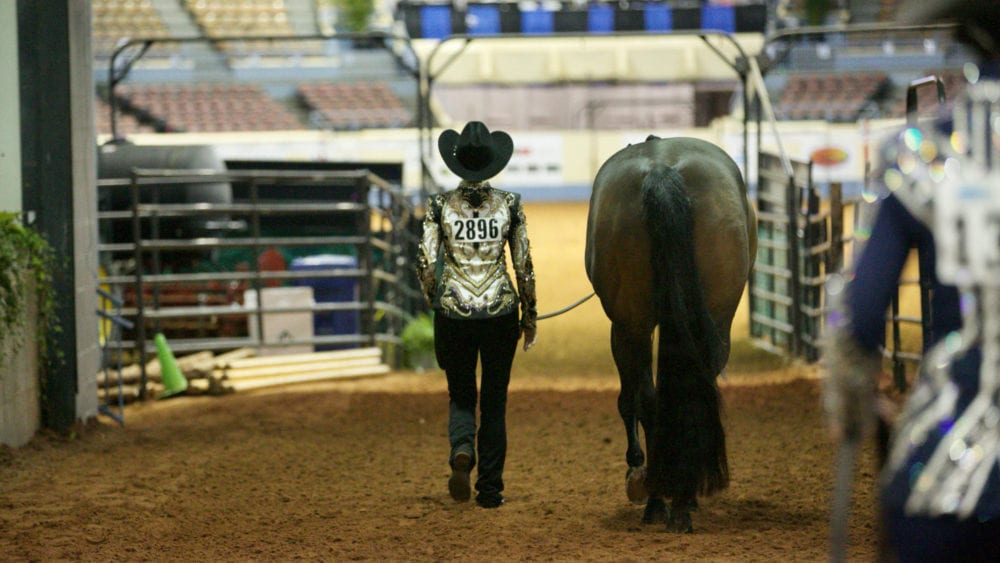Ever feel like affording to show horses when on a budget is like wanting caviar when you can only afford tuna fish? Well, you are not alone. Arguably one of the most frustrating aspects of showing horses is the cost. And the end result is often that many exhibitors find themselves sacrificing the quality of shows that they can attend due to financial restraints.
So how do you step up from the minors to the big leagues if your budget seems like it won’t allow it? Here are some realistic tips to make it possible.
Buy for Quality, Not for Quantity
The first step for ensuring that the funds are available to attend the desired shows throughout the year is to resist the temptation to buy multiples of tack or clothing items when only one or two are needed.
For example, in the early months of the year, when the weather is bleak, and shopping online is therapeutic, resist the urge to buy that pretty new shirt when the three you already have are perfectly suitable. It may only seem like a few hundred dollars now, but in the end, that is the price of one stall for a show in the future.
The best strategy when it comes to obtaining tack or clothing is to take the time to research for and purchase high-quality, well-made items, that fit well and will last, rather than buying the first thing that comes along due to impatience or an “urge.”
A suit that is made custom to your measurements with quality materials and a primary color will last for several show seasons for western competitors. It might cost a little more up front, but will save in the end, rather than an off-the-rack impulse buy in the latest fashion that “might” fit and will probably have to be replaced at the end of the show season if the trend fades quickly (as they so often do).
Do Your Research
To ensure that your proposed budget for the show season will stretch to the end, start the year by researching all the shows you wish to attend and finding out what the costs have been in previous years.
Though most summer shows do not make their showbill available until early spring, it is easy to look on their respective website and find the information for the past year’s show, including stall and entry costs and past years’ results. Research the last two or three years’ show results to figure out how many entries have been in the classes you are interested in showing in, finding out if that show will be worth your while and the money being spent.
Of course, changes may occur in show costs from one year to the next, but doing your research and knowing each desired show’s approximate cost can be essential in determining which ones will be best according to your budget.
Sharing is Caring
When it comes to budgeting, another important tip is to work together with others as often as possible to share to cut costs. Carpooling to shows, sharing a tack stall, making group meals, and splitting a hotel or Airbnb are just a few ways to work together with others within your barn to save money.
Try going in together to rent a car if traveling a long distance (this will save wear and tear on your own), but if renting isn’t in your budget, ask if you can tag along and share gas costs with someone you know is driving. Sharing a tack stall and creating a meal plan for each day is another excellent way to budget.
Often, especially at longer shows, barns will split the extra tack stall cost and make this into a hospitality area with a refrigerator, microwave, tables for crockpots, etc. This can be a huge money saver if it prevents you from having to spend that extra $10-$15 a day on coffee and a breakfast sandwich.
Lastly, if you know that running to the food vendor is a particular weakness of yours, make a plan ahead of time to only bring a certain amount in cash (say, $50) to be your “snack money,” and when it’s gone, it’s gone. It might seem like a small thing, but making this adjustment to your show routine can save an average of $15-20 per day and could be the difference between having the stall money for your next show or not.
Utilize Your Strengths
We’ve all read the tip before to “get an extra job” when it comes to saving money for horse shows, but the truth is, most of us already work a full-time job and getting another in which you have to work around a time-off schedule is not always realistic.
However, it can be a realistic thought to utilize your talents to earn extra money or save money at shows. Many exhibitors have found success in combining their personal skillsets, such as banding and braiding, photography, art, saddle cleaning or writing, to create a small side business with their passion for horses. Because you are merely expanding on something you already love to do, rather than feeling like an extra burden, earning some extra money can be a fun way to save towards your next show.
Recognize Your Limits
Group mentality is a powerful thing, and it can be easy to get caught up (especially in the middle of show season) in the thought process of, “Well, everyone else is going…” when attending shows.
One of the most important aspects of budgeting for the full year is recognizing that you cannot go to every single show. As hard as it may be, it might just be necessary to sit a show or two out in the middle of the season to afford that one you want to go to a few months down the road.
Remember your long-term goals and commit to sacrificing a few shows here and there to afford the more important ones. This will give both you (and your bank account) a well-deserved break and time to save up for the next one.
Final Thoughts
When it comes to showing at the highest levels of competition, it’s tough to work within a budget but certainly not impossible. With some creative cost-cutting methods, practicality, and patience, showing in the big leagues can be achieved for even those with the smallest budgets.
So, if you are someone who has been sitting out the bigger shows because your saddle is older or your showmanship outfit isn’t of the latest trend, remember that classes aren’t won based on the amount of money spent on the “stuff.” Your competition’s $1,000 hunt coat won’t win them the class alone…just like your $100 coat won’t lose you one.








